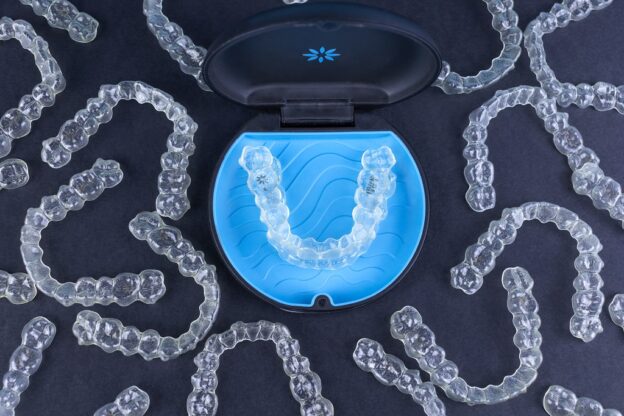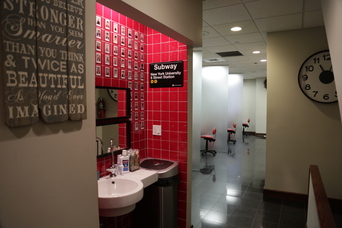Are you wondering if 6 months is enough for Invisalign? In some cases, yes, Invisalign® treatment can be completed in 6 months. However, the average duration for Invisalign treatment is 12 to 18 months. If you only need minor corrections, then you may finish Invisalign in a shorter period.
Exploring Invisalign Treatment
Invisalign® is a system of almost invisible tray aligners in use since 1999. They are an FDA-approved method for straightening teeth. In short, Invisalign is a trendy alternative to traditional metal braces.
The trays work by applying gentle, constant pressure to teeth. The pressure forces the teeth to shift into proper alignment over time. Made with SmartTrack® material, Invisalign® is durable, reliable, and effective in correcting many alignment problems.
Trays come in sets — one top and one bottom. Patients will wear each set for about two weeks before shifting to the next set in the sequence. The trays should remain in place for 20 to 22 hours per day but are removable for drinking, eating, and oral hygiene.
Because the trays are removable, there are no dietary restrictions for wearers. The near-invisibility makes them a very desirable, low-profile, and discreet treatment method. Most people won’t even know that you are wearing braces during your treatment.
Invisalign Express — 6 Months for Invisalign is Possible
Invisalign Express® is a unique treatment available to people needing minor adjustments. There are different levels of Express treatment, including Invisalign Express 5® and Invisalign Express 10®.
Perfect candidates for Invisalign Express® are those who had braces as a teen but neglected to wear their retainer. Teeth will naturally begin to shift back to their original positions without the retainer. Express treatment performs minor adjustments to return teeth to their corrected positioning.
The SmartTrack® material and technology in use with Invisalign Express® is -identical to regular Invisalign®. The most significant difference is the amount of time for treatment and the level of correction necessary.
Factors That Affect Treatment Duration
Several things will affect the length of time you will need to wear Invisalign®. The first is the degree of correction necessary. If you have only minor alignment issues, Invisalign can resolve those quickly, while major alignment problems take longer to correct.
The overall condition of your oral health also plays a role. Your teeth and gums need to be in good shape for Invisalign® treatment. This includes taking care of your oral health during treatment, including your trays.
Following instructions is always important with any orthodontic treatment. Trays should be worn for at least 20 to 22 hours each day. Failure to do so could extend your treatment period (who wants that?).
Not surprisingly, age may also affect the effectiveness of treatment.
Invisalign vs. Budget Aligner Systems
If you have TV or internet access, you have undoubtedly seen many commercials for budget alignment systems. You may be tempted to turn to these budget providers based on cost alone. Yes, they are much less costly. But remember — you get what you pay for.
Budget systems require you to buy a kit that contains a goopy tray impression set. Following the instructions, you create impressions of your teeth. These go to their lab, where they make a 3D map of your mouth.
After that, a certified orthodontist creates a treatment plan for you (supposedly). They send you some tray sets and instructions, and magically your smile will be perfect in no time. But there is plenty that they don’t tell you:
- Limited “guarantees”
- Trays are not as durable as Invisalign®
- Only work on minor alignment problems
Invisalign® has a proven track record spanning 22 years and more than 11 million smiles. Treatment always occurs under the watchful eyes of a certified Invisalign provider. Invisalign has FDA approval as orthodontic treatment.
So, if you have minor alignment problems, you can try the budget tray systems. However, please read the reviews and be a wise consumer. Talk to your dentist and get their opinion also.
What Problems Invisalign Can Fix
Although it may take longer than 6 months for Invisalign treatment in most cases, the reliability, predictability, and consistency of Invisalign® are hard to beat. Invisalign can correct almost all malocclusions from minor to complex.
Crossbite: A crossbite occurs when some of the upper teeth sit inside the lower teeth. The problem can cause chipping or uneven wear of teeth. Problems with receding gums, bone loss, and gum disease can also result from a crossbite.
Overbite: When the upper teeth overlap the lower teeth in the front, it is an overbite. Although some overbite is common, a doctor will correct a deep bite to prevent tooth wear and jaw pain.
Underbite: With an underbite, the lower teeth jut in front of the upper teeth. Incorrect jaw positioning causes an underbite and can make chewing and speaking difficult, in addition to causing rapid tooth wear.
Open bite: It is known as an open bite when the teeth don’t meet with a fully closed mouth. This condition can cause problems with chewing and biting into foods like apples or corn on the cob.
View this post on Instagram
Gap teeth: Gap teeth are when there are noticeable gaps between teeth. Gaps can allow food to get trapped between teeth, cause tender spots, and lead to gum disease.
Crowded and crooked teeth: Many people suffer from crowding or crooked teeth. Problems with maintaining oral hygiene when teeth are crooked or crowded can lead to gum disease, tooth decay, and the situation can worsen over time.
Is Invisalign Right for You?
The chances are excellent that Invisalign® will be perfect for you. Depending on the degree of your alignment problems, you may even have 6 months for Invisalign! The best way to find out is to schedule an appointment with an orthodontist.
Schedule Your Consultation Today
At House of Orthodontia, new patients receive a Complimentary Consultation at their Brooklyn and Manhattan offices. As a Platinum-level Invisalign provider, they are experts in this revolutionary tooth-straightening method.
Ask about accelerated treatment! We wrote the book on it! Clinical Guide to Accelerated Orthodontics.



